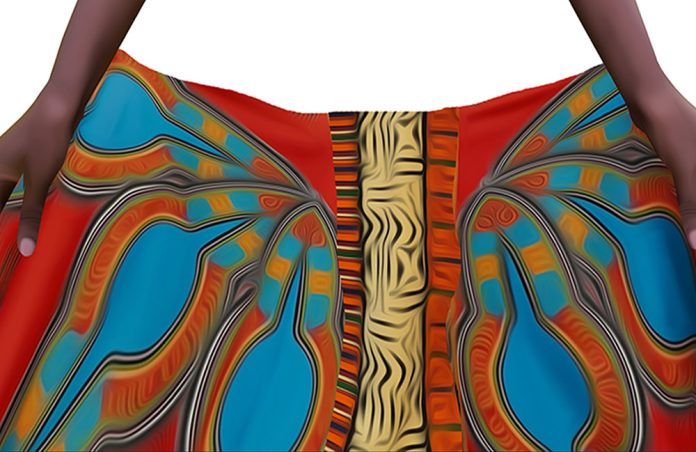Let’s dial back to the 80s and the 90s, shall we? 30 years and above, anyone? Remember how the African wax print (Ankara) locally known as kitenge, was won mostly by old people? It was the ultimate mama and papa look, it just was. Also, it was admired by staunch Catholics because the pictures on the fabric then were known for its supposed ‘baby Jesus and Mary’ print. But not today however, it in fact adorns many faces! See, the pursuit for a fresher, more contemporary, merger between the old the new have seen fashion enthusiasts fall deeply in love with it.
It trickling in across the continent when Nigeria’s Nollywood tore across our screens and with them came to the Ankara like never seen before. They reinvented it to suit their particular styles; office wear, casual or even glamorous occasions, the kitenge became the in thing. Notice how even the trendy men adore its blazers?
And don’t get me started on the ladies, I could write an entire book about the different kitenge showcase they adorn! People now want the fabric on almost everything. I have seen it beautifully employed as pocket squares on shirts, and hair bands for women.
Every fashion house in town worth its name does a couple of outfits using the fabric. In fact, it is the print mostly sought after. The business side of it, is booming. There are over twenty arcades downtown specialising in this fabric. It has opened doors for many designers who were hitherto unknown. And it has helped them express their creativity in numerous and exhilarating ways.
Going global
This begs the question: Why are we now so attracted to this fabric that was once disregarded by many? “I should say that visually, it is very stimulating. And even the technique used to make it; Batik, is interesting,” Solomon Tazibone, a renowned Stylist retorts.
Once western celebrities like Beyonce, Alicia Keys, Nicky Minaji and Michelle Obama adorned it, the world’s eyes were cast intently on Africa as a serious contender for fashion’s emerging markets. “Initially the styles made out of kitenge were boring,” Solomon observes. “And the young and trendy could not be attracted to them.” He says that very creative people have since come up. “They started making silhouettes, nice dresses, and fitting shirts all in modern cuts. And then the trend spread like a burning fire,” he adds.
Besides that, he argues that the fabric has bold colours and it is comfortable on the body. It is also versatile being that it comes in different designs, patterns, colours, materials, styles and can be customized to fit anyone’s style. In fact, there are not as much ready to wear outfits on the market, because most people love theirs custom made. But also, it’s a good thing for the plus size ladies; they don’t hustle looking for what’s fancy and fitting anymore, the kitenge is flexible!
In fact, Shadia Nandhego, a designer at Rechovot fashion house, says that plus size ladies are her majority of clients. What’s more, and most important is that most people especially the young and trendy, wear the print to pay homage to their roots while looking unique in their own way. Africans are increasingly becoming proud of who they really are. Cultural awareness is on the rise. While some may not necessarily be so much into looking African and cultural, they at least want to have a statement piece somewhere in their wardrobe.
One feels cool and progressive that way. Even though one may not own a kitenge dress or shirt, they will at least have a piece of the fabric strategically tailored onto their t-shirt. The bold ones wear kitenge shoelaces. Phone jackets, laptop bags and neckties are some of the accessories which designers are making out of them.
The message behind the kitenge craze is loud and clear: we are African and we love our colours. Amazingly though cultural identity in fashion did not just start with kitenge. No. “It started with accessories like beads, local pearls, jewellery made from Kazuri stones in Kenya,” says Shadia. She tells me it is sort of a cultural revolution.
To that fact, she takes my mind to the creative changes that have been made to the traditional gomesi. Today, ladies step out on functions dressed in the half gomesi, which before could never have been heard of. There has also come the gomesi dress, whereby you don’t have to look for the kikoyi and the kisibiro (belt for the gomesi). All of these are tailored onto it. It is really interesting.
Ladies love it because it’s easy to wear, unlike the original one which had much work to it. It even has a zipper at the back. All these according to Shadia are a testimony to the desire among people to preserve their cultural identity while remaining stylish and unique. The other thing about the kitenge is that it is readily available, even though it is not made here. Solomon tells me that silk and other synthetic fabrics take time to get here. With the kitenge, within two days a designer would have made for you an eye-catching and timeless masterpiece. And you can be sure not to find any other person wearing the same attire as yours.










